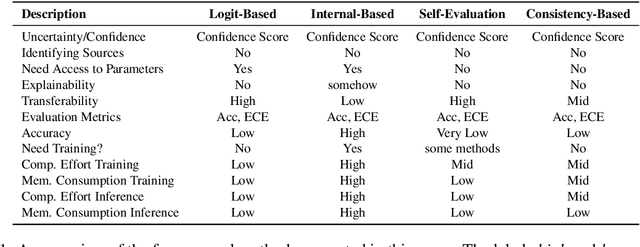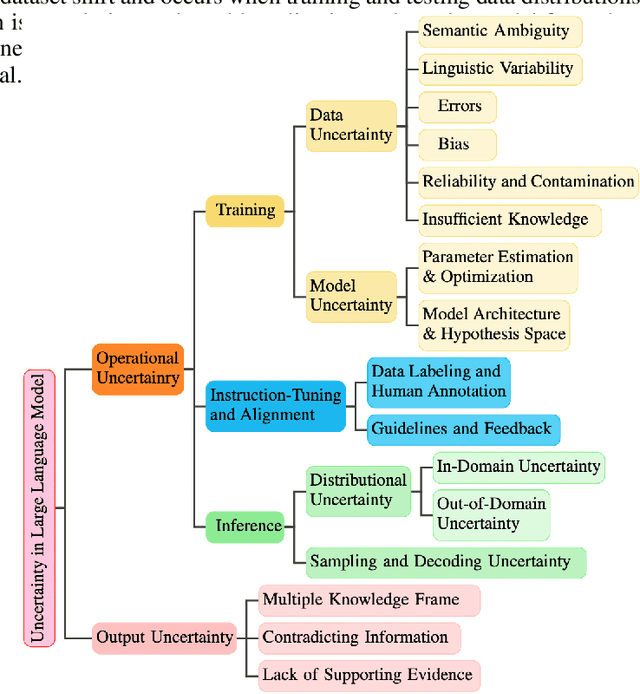Sijia Wang
Graph-based Confidence Calibration for Large Language Models
Nov 03, 2024Abstract:One important approach to improving the reliability of large language models (LLMs) is to provide accurate confidence estimations regarding the correctness of their answers. However, developing a well-calibrated confidence estimation model is challenging, as mistakes made by LLMs can be difficult to detect. We propose a novel method combining the LLM's self-consistency with labeled data and training an auxiliary model to estimate the correctness of its responses to questions. This auxiliary model predicts the correctness of responses based solely on their consistent information. To set up the learning problem, we use a weighted graph to represent the consistency among the LLM's multiple responses to a question. Correctness labels are assigned to these responses based on their similarity to the correct answer. We then train a graph neural network to estimate the probability of correct responses. Experiments demonstrate that the proposed approach substantially outperforms several of the most recent methods in confidence calibration across multiple widely adopted benchmark datasets. Furthermore, the proposed approach significantly improves the generalization capability of confidence calibration on out-of-domain (OOD) data.
AAAR-1.0: Assessing AI's Potential to Assist Research
Oct 29, 2024Abstract:Numerous studies have assessed the proficiency of AI systems, particularly large language models (LLMs), in facilitating everyday tasks such as email writing, question answering, and creative content generation. However, researchers face unique challenges and opportunities in leveraging LLMs for their own work, such as brainstorming research ideas, designing experiments, and writing or reviewing papers. In this study, we introduce AAAR-1.0, a benchmark dataset designed to evaluate LLM performance in three fundamental, expertise-intensive research tasks: (i) EquationInference, assessing the correctness of equations based on the contextual information in paper submissions; (ii) ExperimentDesign, designing experiments to validate research ideas and solutions; (iii) PaperWeakness, identifying weaknesses in paper submissions; and (iv) REVIEWCRITIQUE, identifying each segment in human reviews is deficient or not. AAAR-1.0 differs from prior benchmarks in two key ways: first, it is explicitly research-oriented, with tasks requiring deep domain expertise; second, it is researcher-oriented, mirroring the primary activities that researchers engage in on a daily basis. An evaluation of both open-source and proprietary LLMs reveals their potential as well as limitations in conducting sophisticated research tasks. We will keep iterating AAAR-1.0 to new versions.
Rethinking the Uncertainty: A Critical Review and Analysis in the Era of Large Language Models
Oct 26, 2024


Abstract:In recent years, Large Language Models (LLMs) have become fundamental to a broad spectrum of artificial intelligence applications. As the use of LLMs expands, precisely estimating the uncertainty in their predictions has become crucial. Current methods often struggle to accurately identify, measure, and address the true uncertainty, with many focusing primarily on estimating model confidence. This discrepancy is largely due to an incomplete understanding of where, when, and how uncertainties are injected into models. This paper introduces a comprehensive framework specifically designed to identify and understand the types and sources of uncertainty, aligned with the unique characteristics of LLMs. Our framework enhances the understanding of the diverse landscape of uncertainties by systematically categorizing and defining each type, establishing a solid foundation for developing targeted methods that can precisely quantify these uncertainties. We also provide a detailed introduction to key related concepts and examine the limitations of current methods in mission-critical and safety-sensitive applications. The paper concludes with a perspective on future directions aimed at enhancing the reliability and practical adoption of these methods in real-world scenarios.
Mitigating Exposure Bias in Score-Based Generation of Molecular Conformations
Sep 21, 2024Abstract:Molecular conformation generation poses a significant challenge in the field of computational chemistry. Recently, Diffusion Probabilistic Models (DPMs) and Score-Based Generative Models (SGMs) are effectively used due to their capacity for generating accurate conformations far beyond conventional physics-based approaches. However, the discrepancy between training and inference rises a critical problem known as the exposure bias. While this issue has been extensively investigated in DPMs, the existence of exposure bias in SGMs and its effective measurement remain unsolved, which hinders the use of compensation methods for SGMs, including ConfGF and Torsional Diffusion as the representatives. In this work, we first propose a method for measuring exposure bias in SGMs used for molecular conformation generation, which confirms the significant existence of exposure bias in these models and measures its value. We design a new compensation algorithm Input Perturbation (IP), which is adapted from a method originally designed for DPMs only. Experimental results show that by introducing IP, SGM-based molecular conformation models can significantly improve both the accuracy and diversity of the generated conformations. Especially by using the IP-enhanced Torsional Diffusion model, we achieve new state-of-the-art performance on the GEOM-Drugs dataset and are on par on GEOM-QM9. We provide the code publicly at https://github.com/jia-975/torsionalDiff-ip.
Multiplex Graph Contrastive Learning with Soft Negatives
Sep 12, 2024Abstract:Graph Contrastive Learning (GCL) seeks to learn nodal or graph representations that contain maximal consistent information from graph-structured data. While node-level contrasting modes are dominating, some efforts commence to explore consistency across different scales. Yet, they tend to lose consistent information and be contaminated by disturbing features. Here, we introduce MUX-GCL, a novel cross-scale contrastive learning paradigm that utilizes multiplex representations as effective patches. While this learning mode minimizes contaminating noises, a commensurate contrasting strategy using positional affinities further avoids information loss by correcting false negative pairs across scales. Extensive downstream experiments demonstrate that MUX-GCL yields multiple state-of-the-art results on public datasets. Our theoretical analysis further guarantees the new objective function as a stricter lower bound of mutual information of raw input features and output embeddings, which rationalizes this paradigm. Code is available at https://github.com/MUX-GCL/Code.
Advancing Chart Question Answering with Robust Chart Component Recognition
Jul 19, 2024Abstract:Chart comprehension presents significant challenges for machine learning models due to the diverse and intricate shapes of charts. Existing multimodal methods often overlook these visual features or fail to integrate them effectively for chart question answering (ChartQA). To address this, we introduce Chartformer, a unified framework that enhances chart component recognition by accurately identifying and classifying components such as bars, lines, pies, titles, legends, and axes. Additionally, we propose a novel Question-guided Deformable Co-Attention (QDCAt) mechanism, which fuses chart features encoded by Chartformer with the given question, leveraging the question's guidance to ground the correct answer. Extensive experiments demonstrate that the proposed approaches significantly outperform baseline models in chart component recognition and ChartQA tasks, achieving improvements of 3.2% in mAP and 15.4% in accuracy, respectively. These results underscore the robustness of our solution for detailed visual data interpretation across various applications.
Debate as Optimization: Adaptive Conformal Prediction and Diverse Retrieval for Event Extraction
Jun 18, 2024Abstract:We propose a multi-agent debate as optimization (DAO) system for event extraction, where the primary objective is to iteratively refine the large language models (LLMs) outputs through debating without parameter tuning. In DAO, we introduce two novel modules: the Diverse-RAG (DRAG) module and the Adaptive Conformal Prediction (AdaCP) module. DRAG systematically retrieves supporting information that best fits the debate discussion, while AdaCP enhances the accuracy and reliability of event extraction by effectively rejecting less promising answers. Experimental results demonstrate a significant reduction in the performance gap between supervised approaches and tuning-free LLM-based methods by 18.1% and 17.8% on ACE05 and 17.9% and 15.2% on CASIE for event detection and argument extraction respectively.
Targeted Augmentation for Low-Resource Event Extraction
May 14, 2024Abstract:Addressing the challenge of low-resource information extraction remains an ongoing issue due to the inherent information scarcity within limited training examples. Existing data augmentation methods, considered potential solutions, struggle to strike a balance between weak augmentation (e.g., synonym augmentation) and drastic augmentation (e.g., conditional generation without proper guidance). This paper introduces a novel paradigm that employs targeted augmentation and back validation to produce augmented examples with enhanced diversity, polarity, accuracy, and coherence. Extensive experimental results demonstrate the effectiveness of the proposed paradigm. Furthermore, identified limitations are discussed, shedding light on areas for future improvement.
JailbreakLens: Visual Analysis of Jailbreak Attacks Against Large Language Models
Apr 12, 2024Abstract:The proliferation of large language models (LLMs) has underscored concerns regarding their security vulnerabilities, notably against jailbreak attacks, where adversaries design jailbreak prompts to circumvent safety mechanisms for potential misuse. Addressing these concerns necessitates a comprehensive analysis of jailbreak prompts to evaluate LLMs' defensive capabilities and identify potential weaknesses. However, the complexity of evaluating jailbreak performance and understanding prompt characteristics makes this analysis laborious. We collaborate with domain experts to characterize problems and propose an LLM-assisted framework to streamline the analysis process. It provides automatic jailbreak assessment to facilitate performance evaluation and support analysis of components and keywords in prompts. Based on the framework, we design JailbreakLens, a visual analysis system that enables users to explore the jailbreak performance against the target model, conduct multi-level analysis of prompt characteristics, and refine prompt instances to verify findings. Through a case study, technical evaluations, and expert interviews, we demonstrate our system's effectiveness in helping users evaluate model security and identify model weaknesses.
A Survey of Document-Level Information Extraction
Sep 23, 2023Abstract:Document-level information extraction (IE) is a crucial task in natural language processing (NLP). This paper conducts a systematic review of recent document-level IE literature. In addition, we conduct a thorough error analysis with current state-of-the-art algorithms and identify their limitations as well as the remaining challenges for the task of document-level IE. According to our findings, labeling noises, entity coreference resolution, and lack of reasoning, severely affect the performance of document-level IE. The objective of this survey paper is to provide more insights and help NLP researchers to further enhance document-level IE performance.
 Add to Chrome
Add to Chrome Add to Firefox
Add to Firefox Add to Edge
Add to Edge